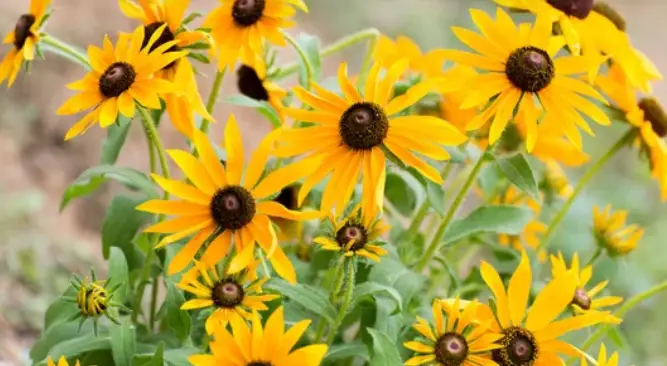Whether you live in a warm climate or a cold one, you’ll be happy to know that there are a lot of beautiful, low maintenance full sun perennials that you can plant in your yard or garden. These plants are not only beautiful, but they’re also pretty easy to grow.
So here is a list of Low Maintenance Full Sun Perennials below.
1) Coneflower
Whether you’re planning a large perennial landscape or an open garden, the Coneflower makes a great addition. It grows in full sun and is easy to maintain.
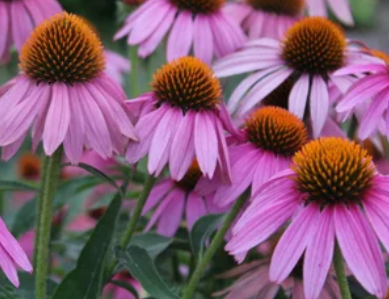
Coneflowers are also a great plant to attract pollinators, such as bees and butterflies. They are also a great addition to container gardens, as they’re hardy and drought resistant.
A popular variety in North Carolina gardens is the purple coneflower. It blooms from June to August, providing a long bloom period. The flowers are purple with dark orange centers.
The coneflower also makes a great choice for a garden that needs a splash of color in the fall. It will produce a large number of blooms, up to 25 per season. It’s also a great choice for planting in a garden bed with other flowering perennials.
Coneflowers are also very tolerant of drought and clay soils. They grow well in both full sun and part shade. They are also a good choice for a wild meadow. They are native to a wide variety of regions in the U.S., and are well known for their medicinal properties.
2) Lavender
Whether you’re growing lavender for its fragrant flowers or for its medicinal uses, this easy-to-grow perennial has a lot to offer.
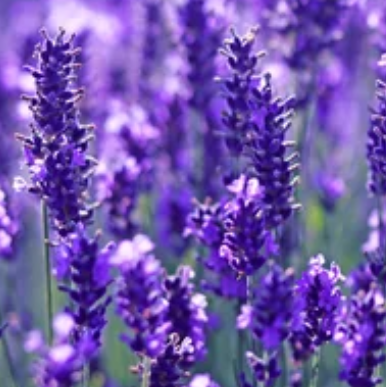
It’s drought-resistant once it’s established, attracts hummingbirds and bees, and doesn’t require much care. Depending on the variety, lavender can grow up to 30 inches tall.
The best time to plant lavender is in the spring. It will need at least 48 inches of space to grow. It will also need a well-drained, sandy soil. If your soil is too acidic or hard, you can amend it with lime.
Lavender can also be grown in containers. If you decide to grow lavender in pots, make sure you purchase a succulent potting mix. This mix will provide the proper drainage and keep the crowns from becoming overly wet.
Lavender has a distinctive fragrance that can repel insects and animals. Rabbits and deer don’t tend to browse on lavender. However, elk may accidentally browse.
Lavender is also an excellent source of essential oil. Its flowers produce a strong scent that can be used for making potpourri.
3) Hibiscus
Whether you want a tropical look for your garden or want a showy hibiscus for your patio, hibiscus is a great addition.
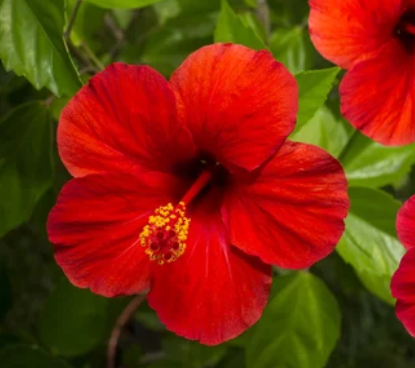
Hibiscus plants are low maintenance, and bloom in beautiful colors that will add a tropical touch to your summer garden. You can also grow hibiscus in containers.
You’ll want to be sure you choose a variety that thrives in your climate, because tropical hibiscus does not like cold weather.
If you want to grow hibiscus in containers, you’ll want to choose a variety that has large, vibrant flowers. You’ll also want to be sure you have ample moisture and well-drained soil. In addition, you’ll want to provide protection for your hibiscus over the winter months.
Hibiscus varieties come in many shapes and sizes. They can be grown in containers, or as a specimen plant in the perennial garden. There are also shrub forms of hibiscus that are perfect for fence lines or screens. Some shrub forms grow to 12 feet tall and thrive in cold zones. Depending on the variety, you’ll want to choose a hibiscus that grows best in full sun.
4) Hardy geraniums
Whether you are looking for an easy to care for ground cover, or looking for a plant that provides a long bloom season, Hardy Geraniums is the ideal plant for you.
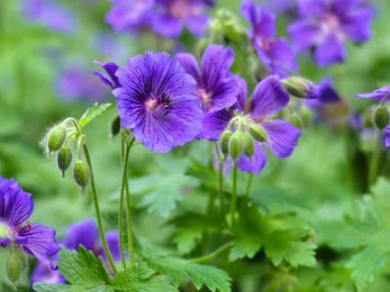
These plants are low maintenance perennial that grows well in most types of soil, including sandy soil. They are resistant to pests, disease, and deer.
They can be planted in containers, rock gardens, or as ground cover. Hardy geraniums grow well in areas where they are exposed to sunlight for at least four hours a day. They are also great for pollinators.
Geraniums can grow in a variety of soils, including acidic, alkaline, and moist. They are not tolerant of standing water, but they do tolerate moderate drought. It is important to plant them in adequate drainage holes and not sit them in puddles of water. Geraniums will grow better in areas with medium moisture and good soil pH.
When planting, Geraniums are best planted in late fall or winter. They need to be planted in holes with adequate drainage, and watered after the soil has settled around the roots. This ensures that the plants will establish well. They will grow better if you add some organic matter to the soil, such as compost or rotted manure.
5) Pussytoes
Among the low maintenance full sun perennials Pussytoes are easy to grow and don’t require much maintenance.
These ground covers will form clumps that are ideal for rock gardens and landscape beds. They are also drought-tolerant once they are established.
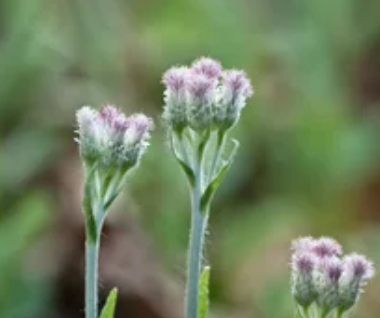
Pussytoes can grow in full sun or partial shade. They prefer moist, well-draining soil. They will grow well in areas where the pH is a little on the acidic side.
Pussytoes are hardy to Zones 3 through 8. They grow up to 12 inches tall and have small, woolly leaves. They produce fluffy white flowers that look like pussycat toes. They bloom in late spring. They are popular with birds, butterflies, and pollinators.
Pussytoes, which are also known as Field Pussytoes, are a daisy family plant. They are native to the eastern United States. They grow well in rock gardens, but they are also excellent in mesic to dry conditions. They bloom for three weeks and produce flowers on short stalks.
Pussytoes have an upright spreading habit. They are also a great ground cover for spring bulbs. They prefer soil with a pH range from 6.0 to 8.5.
6) Sedums
Whether you’re looking for a succulent that needs little care, or a plant to attract bees and butterflies, Sedums are an easy addition to your garden. They come in many colors and shapes, and are also easy to propagate.
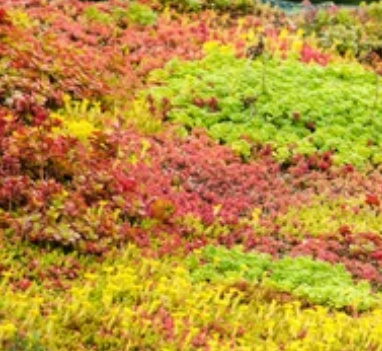
Sedums grow best in a dry climate, but they also are a great choice for drought-tolerant gardens. Many varieties are available in pots for home gardeners, and others are available in mail order. You can even buy large plug plants that are ready for planting.
Sedums need well-draining soil, but they also do well in gravelly or sandy soil. If you have heavy clay soil, adding some gravel to the area can improve drainage.
You can grow sedums from seed, cuttings or rooted cuttings. Seeds can be very small, so it is important to cover them with vermiculite to prevent them from drying out. You can also plant them in a container, but make sure the container has drainage holes.
Some sedum varieties are also attractive groundcover plants. They are great for rocky hillside gardens, or rock gardens.
7) Rudbeckia
Whether you’re looking for a low maintenance full sun perennial or want to plant a native plant in your garden, Rudbeckia is a great choice. With a wide variety of varieties available, it’s easy to find one that suits your needs.
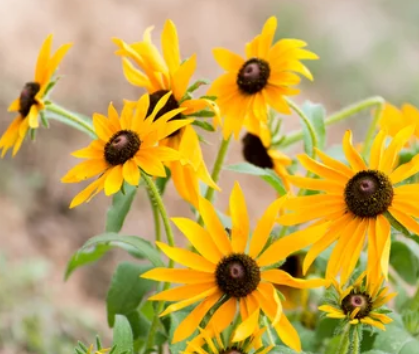
Rudbeckia is easy to grow. You can start seeds indoors in early spring and transplant them into your garden when it’s warm enough. Depending on your region, you may also want to start Rudbeckia plants in containers.
If you live in a hot, humid climate, you may want to avoid Rudbeckias. Those that are grown in these conditions may be prone to powdery mildew or botrytis.
However, there are ways to prevent these problems. Firstly, make sure the soil is well drained. Secondly, add some well-rotted compost to the soil when you’re preparing to plant. Lastly, make sure that the plant is exposed to plenty of sunlight.
Rudbeckias are ideal for cottage gardens and garden beds. They’re also a great cut flowers. The flowers are drought-tolerant and attract pollinators. The flowers are also easy to grow.
8) Woolly Yarrow
Yarrow is a perennial flower that is a great cut flower. It blooms in spring and grows in sun or shade. It also grows well in sandy soil. It is also drought resistant and can be used in a container garden.

It grows to about 1 to 2 feet tall. It is an easy plant to grow. It thrives in full sun and part shade. It is a favorite flower of hummingbirds. It is also deer resistant.
The foliage of Woolly Yarrow is silvery gray and fuzzy. It grows in clusters of 6-12″ foliage. The flowers are rosy pink or soft yellow. It prefers to grow in dry soil, but can take partial shade. It divides every few years. It grows well in containers or rock gardens.
Low-growing perennials are ideal for front of flower beds. They come back year after year and are easy to care for. They can be used along walkways and pathways. They also make a great ground cover. They are also popular edging plants for sunny spots.

